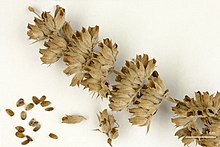Salvia apiana
| White sage | |
|---|---|

| |
| Scientific classification | |
| Kingdom: | Plantae |
| Clade: | Tracheophytes |
| Clade: | Angiosperms |
| Clade: | Eudicots |
| Clade: | Asterids |
| Order: | Lamiales |
| Family: | Lamiaceae |
| Genus: | Salvia |
| Species: | S. apiana
|
| Binomial name | |
| Salvia apiana | |
Salvia apiana, the Californian white sage, bee sage, or sacred sage is an evergreen perennial shrub that is native to the southwestern United States and northwestern Mexico, found mainly in the coastal sage scrub habitat of Southern California and Baja California, on the western edges of the Mojave and Sonoran deserts.[1]
Description[edit]
Salvia apiana is a shrub that reaches 1.3 to 1.5 metres (4.3 to 4.9 ft) tall and 1.3 metres (4.3 ft) wide. The whitish evergreen leaves are 3 to 9 cm (1.2 to 3.5 in) and persist throughout the year; they are opposite with crenulate margins. Leaves are thickly covered in hairs that trigger oil glands; when rubbed oils and resins are released, producing a strong aroma.[2] The flowers are very attractive to bees, which is described by the specific epithet, apiana. Several 1 to 1.3 metres (3.3 to 4.3 ft) flower stalks, sometimes pinkish colored, grow above the foliage in the spring. Flowers are white to pale lavender.[1]
Distribution and habitat[edit]
Californian white sage is a common plant that requires well-drained dry soil, full sun, and little water. The plant occurs on dry slopes in coastal sage scrub, chaparral, and yellow-pine forests of Southern California to Baja California at less than 1,500 metres (4,900 ft) elevation.[1]
Ecology[edit]
Flowers attract varied pollinators including bumblebees, carpenter bees, Bombyliidae, and hummingbirds.[3] However most of these species are ineffective pollinators, with only three species of carpenter bee and one species of bumblebee actually leading to routine pollination.[2]
Pests and disease[edit]
The terpenoids and essential oils found in white sage likely deter herbivory.[2]
Uses[edit]

Salvia apiana is widely used by Native American peoples on the Pacific coast of the United States. The seed is a primary, traditional ingredient in pinole, a staple food. The Cahuilla people have traditionally harvested large quantities of the seed, then mixed it with wheat flour and sugar to make gruel and biscuits. The leaves and stems are a traditional food among the Chumash people and neighboring communities.
For healing use, several tribes have traditionally used the seed for removing foreign objects from the eye, similar to the way that Clary sage seeds have been used in Europe. A tea from the roots is traditional among the Cahuilla women for healing and strength after childbirth.
Different parts of the plant are also used in ritual purification by several Native American cultures.[4]
Conservation[edit]
Over-harvest of wild Californian white sage populations is a concern held by many Native American groups and conservationists.[5] Over-harvesting is negatively affecting the wild population and distribution of white sage.[5] It is believed that illegal harvest is occurring on public lands and non-permitted harvesting is also taking place on private land. In June 2018, four people were arrested for the illegal harvest of 400 pounds of white sage in North Etiwanda Preserve of Rancho Cucamonga, California.[6] Due to the potential for overharvesting and the plant's sacredness to certain Indigenous tribes, many Native Americans have asked non-Natives to refrain from the usage of white sage.
Deputies said in a statement that white sage is protected by the Endangered Species Act of 1973, which is a common misconception. Collecting plants without permission from a landowner or land manager is illegal.[7] Although Californian white sage is not listed on the Endangered Species List,[8] conservationists are still concerned about the future survival and distribution of the species.[5] The destruction of white sage has become a focus of the Tongva Taraxat Paxaavxa Conservancy.[9]
Cultivation[edit]
Salvia apiana prefers a sunny location, well draining soil, and good air circulation. It easily hybridizes with other Salvia species, particularly Salvia leucophylla and Salvia clevelandii.[1]
References[edit]
- ^ a b c d Clebsch, Betsy; Carol D. Barner (2003). The New Book of Salvias. Timber Press. pp. 34–36. ISBN 978-0-88192-560-9.
- ^ a b c "Salvia apiana Jepson" (PDF). United States Forest Service. 13 October 2010.
- ^ "White Sage, Salvia apiana". calscape.org. Retrieved 2019-09-18.
- ^ "USDA Plants Database" (PDF). Archived from the original (PDF) on 2012-11-22.
- ^ a b c Leopold, Susan (24 June 2019). "What is going on with White Sage?". United Plant Savers. Retrieved 21 Oct 2019.
- ^ "400 pounds of endangered sage seized, 4 arrested at North Etiwanda Preserve". Press Enterprise. 2018-06-26. Retrieved 2018-11-16.
- ^ "Law section". leginfo.legislature.ca.gov. Retrieved 2018-11-16.
- ^ "USFWS Federally Endangered Species: Flowering plants". U.S. Fish and Wildlife Service.
- ^ "Designing for Green Justice: Centering Indigenous Land Access, Stewardship, and Return & Protect White Sage Campaign". ArtCenter College of Design. Retrieved 2023-01-04.
External links[edit]
- Plant of the Month: White Sage at JSTOR Daily, July 27, 2022
- White Sage - photograph
- Jepson Flora Project - Salvia apiana
- Salvia apiana in the CalPhotos photo database, University of California, Berkeley
- "Salvia apiana". Calflora. Berkeley, California: The Calflora Database.
- "Salvia apiana". Plants for a Future.
- Salvia
- Flora of California
- Flora of Baja California
- Flora of the California desert regions
- Flora of the Sonoran Deserts
- Natural history of the California chaparral and woodlands
- Natural history of the Colorado Desert
- Natural history of the Mojave Desert
- Natural history of the Peninsular Ranges
- Natural history of the Santa Monica Mountains
- Natural history of the Transverse Ranges
- Plants used in Native American cuisine
- Plants used in traditional Native American medicine
- Garden plants of North America
- Drought-tolerant plants
